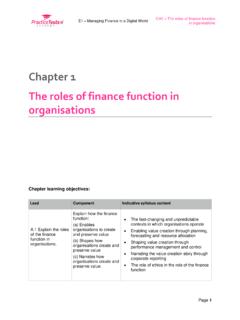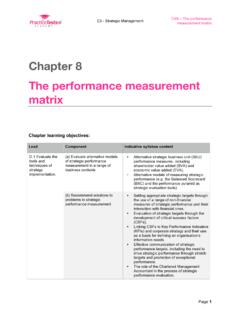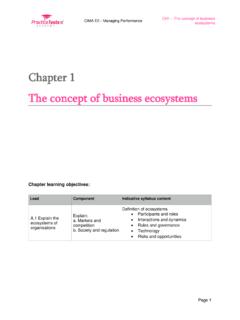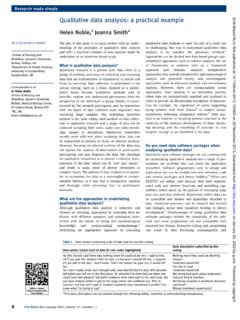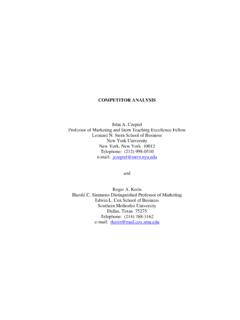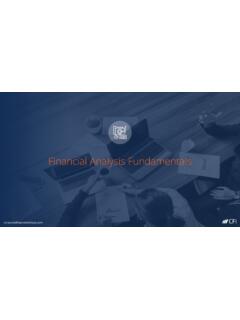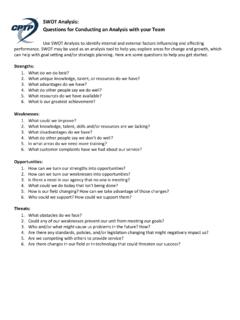Transcription of Chapter 4 Strategic analysis: External Environmental Analysis
1 E3 - Strategic Management CH4 Strategic Analysis : External Environmental Analysis Page 1 Chapter 4 Strategic Analysis : External Environmental Analysis Chapter learning objectives: Lead Component Indicative syllabus content Evaluate the influence of key External factors on an organisation s strategy. (a) Evaluate the influence and impact of the External environment on an organisation and its strategy. Different organisation environments (including profit and not-for-profit organisations). The key Environmental drivers of organisational change and their prioritisation. Note: The emphasis should be on the evaluation and prioritisation of the Environmental drivers specific to the organisation and not upon the production of a generic PEST Analysis . Evaluate the process of strategy formulation.
2 (b) Recommend Strategic options. The identification and evaluation of Strategic options, including the application of the suitability, acceptability and feasibility framework. Evaluate tools and techniques used in strategy formulation. (a) Evaluate Strategic Analysis tools. Audit of key resources and capabilities needed for strategy implementation. Forecasting and the various techniques used: trend Analysis , system modelling, in-depth consultation with experts ( the Delphi method). E3 - Strategic Management CH4 Strategic Analysis : External Environmental Analysis Page 2 1. Introduction Purpose of Environmental Analysis To characterise the environment that can influence the business. To identify threats and be prepared to handle them appropriately. To identify opportunities and be prepared to benefit from them in a timely manner.
3 To identify competitive strengths and weaknesses. To recognise competition in the market and how to compete more effectively. To identify stakeholders and what they require from the organisation. Drawbacks of Environmental Analysis New technology constantly changes the competitive environment by introducing new products and their placement in the markets. A continuously weakening global economy has led to problems with the predictability of demand. An increasing number of factors affect an organisation as national borders blur. The emergence of high-growth economies (BRIC). Regular Environmental Analysis is necessary if it is to have any relevance to the organisation. Tools E3 - Strategic Management CH4 Strategic Analysis : External Environmental Analysis Page 3 2.
4 PEST Analysis Assesses the general environment. Specifically considers market conditions, growing or declining. Can also be used to identify opportunities and threats (SWOT). Focuses on four parameters: - Political factors - Economic factors - Social factors - Technological factors Other variations of PEST include: - SLEPT (social, legal economic, political, technological). - PESTLE/PESTEL (political, economic, social, technological, legal, Environmental ). E3 - Strategic Management CH4 Strategic Analysis : External Environmental Analysis Page 4 Drawbacks of PEST Analysis PEST will quickly become irrelevant in industries where conditions change quickly. The opinions of different managers limit the objectivity of the Analysis . It is impossible to identify each and every factor that is important for an organisation.
5 3. Porter s Five Forces Analysis This model focuses on conditions within a specific industry. The five forces decide whether or not a business in that industry is profitable. Generally, the greater the forces, the lower the prospective profit potential. Success lies in minimising these forces so as to increase one s profit potential. E3 - Strategic Management CH4 Strategic Analysis : External Environmental Analysis Page 5 Power of buyers This is the bargaining power. Bargaining power is high when: - There are many buyers - There are many suppliers - Switching costs are low Power of suppliers This is the bargaining power of suppliers, the influence of suppliers on the customer. Power is high when: - There are few suppliers, a monopoly - The product is crucial to the customer - Switching costs are high Threat of new entrants This is dependent upon the barriers to entry in an industry.
6 An organisation must know whether it is trying to enter or trying to prevent others from entering an industry. The barriers need to be identified. If the organisation seeks to enter, they will wish to be able to overcome these barriers. If it is trying to prevent others from entering, it will try to intensify these barriers or paint the barriers as too difficult to overcome. Some of the barriers may be: - Economies of scale - High capital requirements - Difficult access to distribution networks - Long-standing relationships of the companies in the industry - Expectation of retaliation from market leaders - Cumbersome legal requirements - Strong product differentiation - High switching costs for customers E3 - Strategic Management CH4 Strategic Analysis : External Environmental Analysis Page 6 Threat of substitutes Substitutes fulfil essentially similar needs or uses.
7 Substitutes may be in direct or indirect competition. For instance: - Juices or soft drinks - Luxury car or luxury bike - A vacation or a home theatre Rivalry among competitors Competition among similar products, Coke and Pepsi Competition may be intense where: - competing organisations are of similar size. - Competitors have a similar market share. - The market is mature the further along the life cycle, the greater the competition. - Differentiation of products is low, leading to greater rivalry on price. - Storage costs or capacity are high, necessitating the lowering of prices to increase sales. - There are high exit barriers, generating a fiercer need to stay and compete. Drawbacks of Porter s model Customers are perceived as competitors (power of buyers).
8 Its usefulness is low in dynamic industries where circumstances keep changing rapidly. It is difficult to apply to companies with specific differentiated competences. It is important to consider influential government actions in addition to these five forces. This model is based on the assumption that there are no alliances in business, which is false. Not suitable for not-for-profit organisations as it focuses on profitability. E3 - Strategic Management CH4 Strategic Analysis : External Environmental Analysis Page 7 5. Industry life cycle Analysis There are several stages in a product s life cycle. This Analysis allows the implementation of different strategies at different stages to gain maximum benefit. This life cycle Analysis can be applied to both products and industries.
9 The life cycle comprises the following stages: - Introduction - Growth - Maturity - Decline Introduction stage New product introduced in the market. Low awareness of product. Low initial demand for new product. Production is, therefore, low at this stage. Costs are likely to be high at this stage, research & development and promotional costs. Competition is low. E3 - Strategic Management CH4 Strategic Analysis : External Environmental Analysis Page 8 Pricing strategies could be either: - Penetration price: setting a low price to gain market share. - Price skimming: setting a high price to gain maximum benefit in the initial stages. Growth stage Awareness of product increases. Demand levels increase. Market as a whole grows. Production levels consequently increase.
10 This might result in economies of scale. There might be price competition as competition grows. New competitors enter the market. Profitability and cash flows increase. It is likely that initial costs are recovered. It is important to develop brand loyalty at this stage. Products may be differentiated as more rivals enter the market. Maturity stage Market growth reduces. Market becomes saturated. Competition becomes fiercer. Market share can only be increased at the expense of another. Extension strategies are sought for the product. Market niches may be developed or exploited. New product variations may be developed. Decline stage Market shrinks. Buyers reduce. Demand lowers. Smaller suppliers exit. Prices are lowered (price cutting) to gain any share from leaving competitors.

